Enterprise System Implementation
VerifiedAdded on 2023/03/30
|14
|870
|215
Presentation
AI Summary
This presentation discusses the implementation of enterprise systems in organizations, with a case study of Qantas Airways. It explores the challenges faced during implementation and analyzes the success achieved. The presentation also highlights the benefits of enterprise systems in improving operational efficiency.
Contribute Materials
Your contribution can guide someone’s learning journey. Share your
documents today.
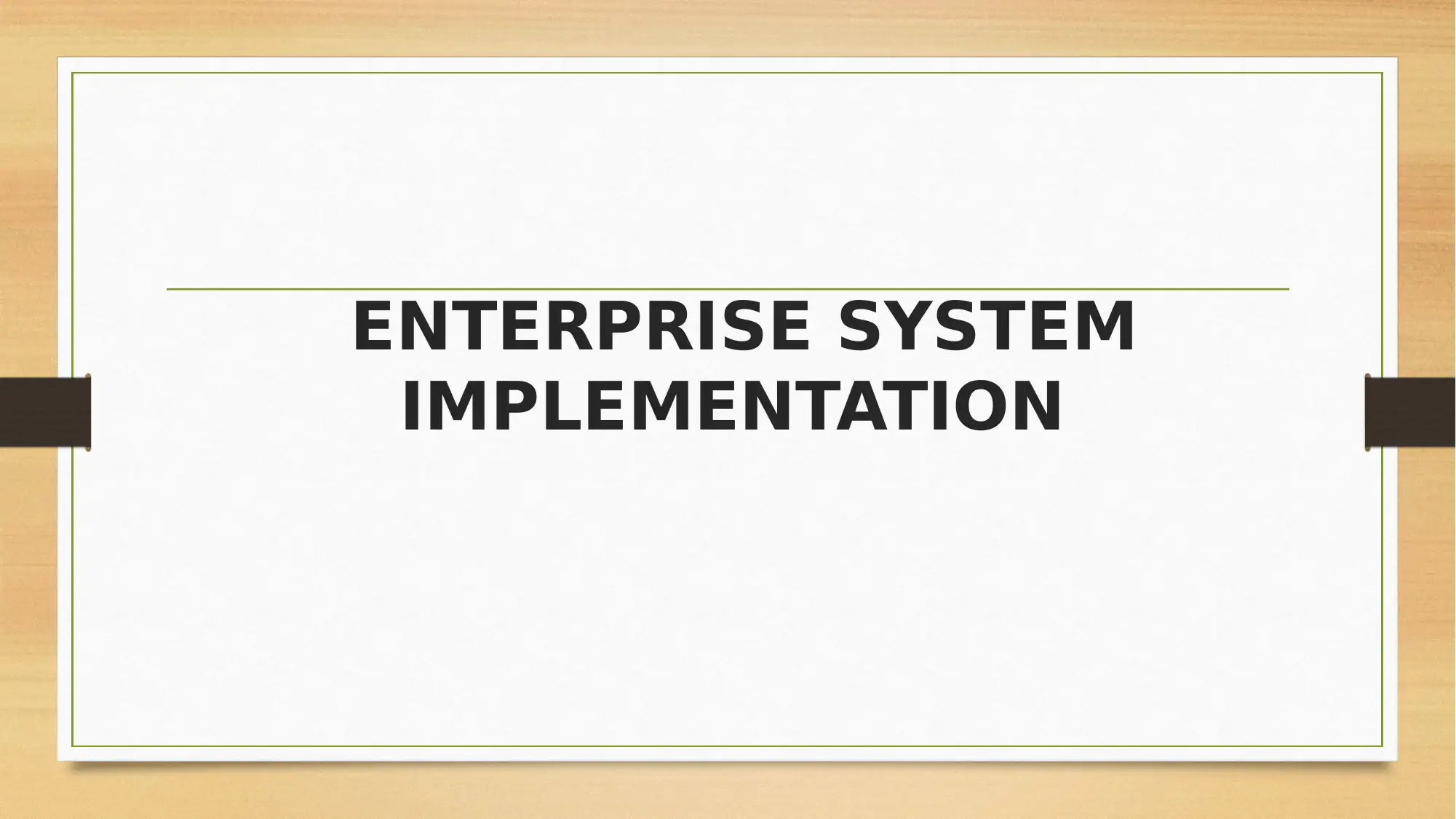
ENTERPRISE SYSTEM
IMPLEMENTATION
IMPLEMENTATION
Secure Best Marks with AI Grader
Need help grading? Try our AI Grader for instant feedback on your assignments.
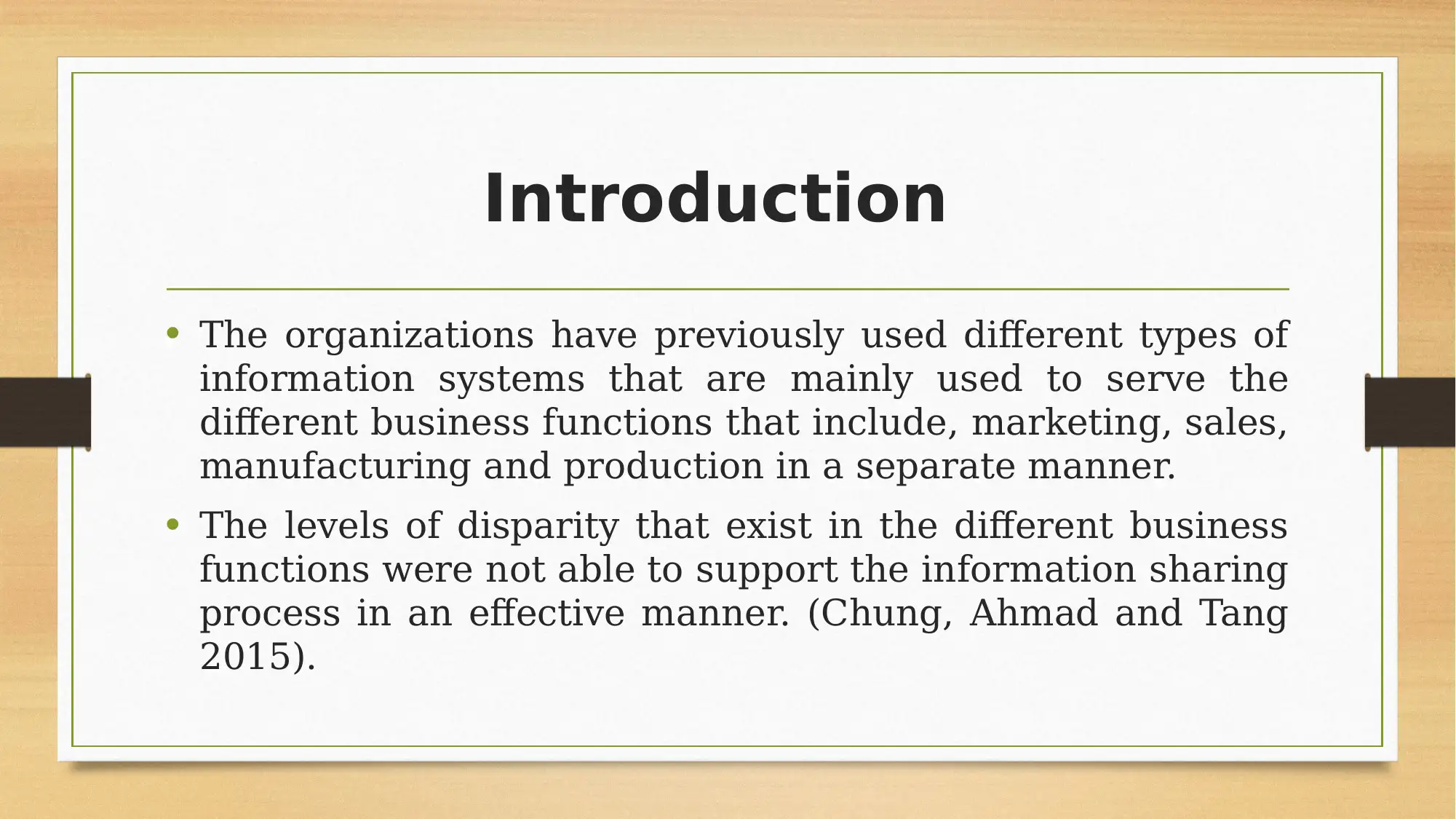
Introduction
• The organizations have previously used different types of
information systems that are mainly used to serve the
different business functions that include, marketing, sales,
manufacturing and production in a separate manner.
• The levels of disparity that exist in the different business
functions were not able to support the information sharing
process in an effective manner. (Chung, Ahmad and Tang
2015).
• The organizations have previously used different types of
information systems that are mainly used to serve the
different business functions that include, marketing, sales,
manufacturing and production in a separate manner.
• The levels of disparity that exist in the different business
functions were not able to support the information sharing
process in an effective manner. (Chung, Ahmad and Tang
2015).

Introduction CONTINUED ….
• The nature of the Enterprise systems that are adopted by
the organizations will also be analysed in detail. The
organization that has been taken into consideration for
analysis is Qantas Airways that has recently implemented
Enterprise Resource Planning or ERP process (De Toni,
Fornasier and Nonino 2015).
• The nature of the Enterprise systems that are adopted by
the organizations will also be analysed in detail. The
organization that has been taken into consideration for
analysis is Qantas Airways that has recently implemented
Enterprise Resource Planning or ERP process (De Toni,
Fornasier and Nonino 2015).
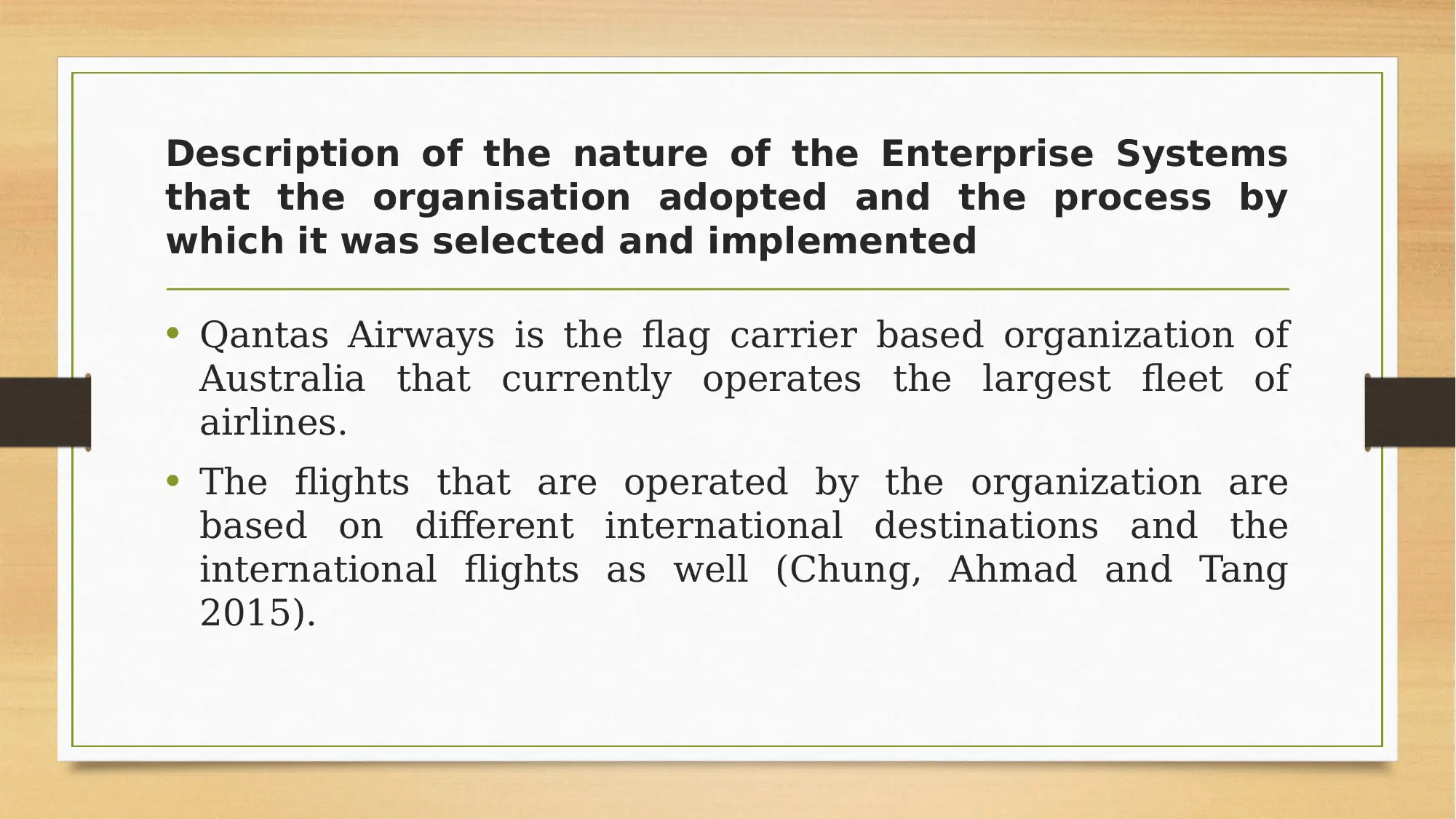
Description of the nature of the Enterprise Systems
that the organisation adopted and the process by
which it was selected and implemented
• Qantas Airways is the flag carrier based organization of
Australia that currently operates the largest fleet of
airlines.
• The flights that are operated by the organization are
based on different international destinations and the
international flights as well (Chung, Ahmad and Tang
2015).
that the organisation adopted and the process by
which it was selected and implemented
• Qantas Airways is the flag carrier based organization of
Australia that currently operates the largest fleet of
airlines.
• The flights that are operated by the organization are
based on different international destinations and the
international flights as well (Chung, Ahmad and Tang
2015).
Secure Best Marks with AI Grader
Need help grading? Try our AI Grader for instant feedback on your assignments.
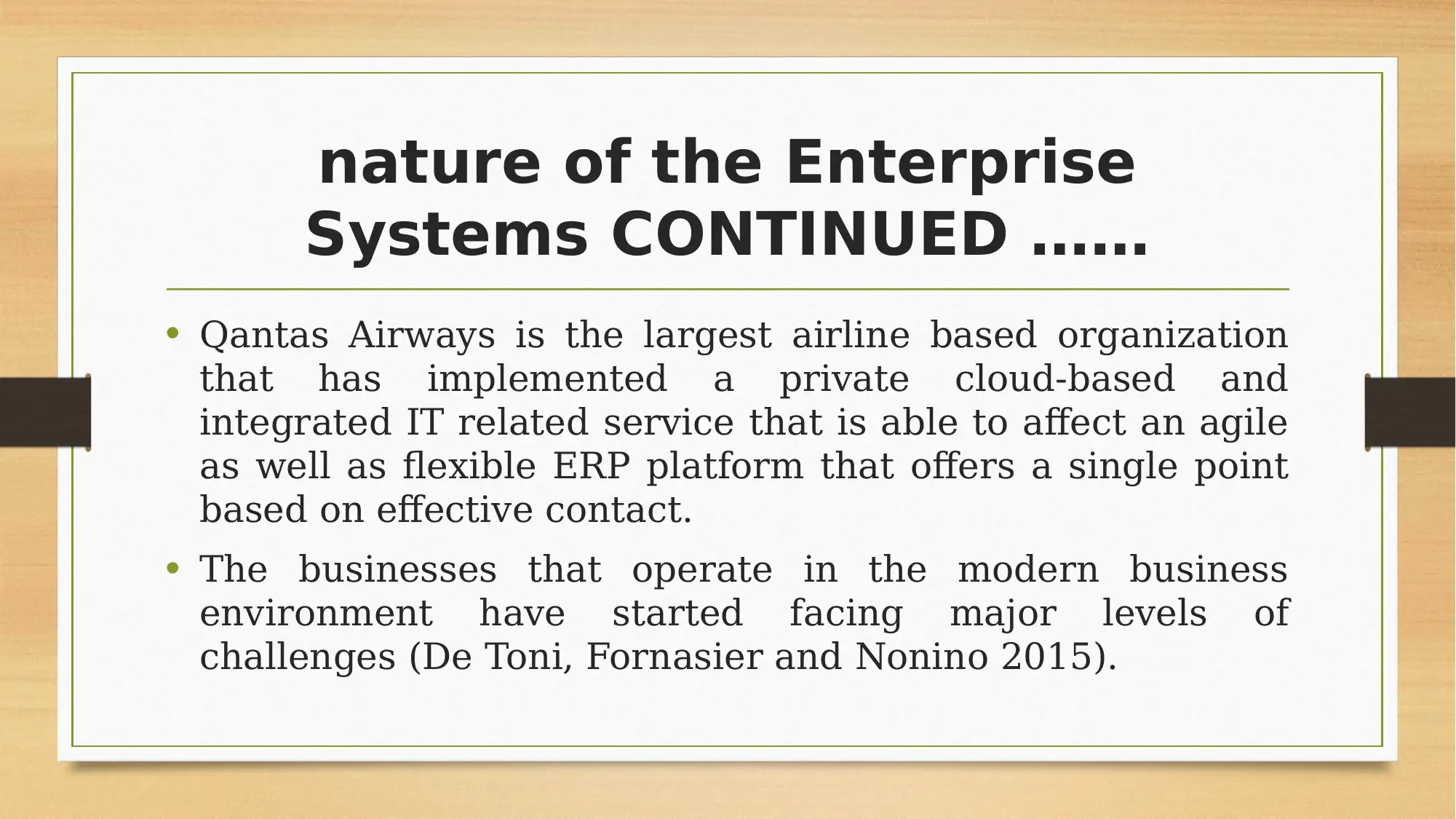
nature of the Enterprise
Systems CONTINUED ……
• Qantas Airways is the largest airline based organization
that has implemented a private cloud-based and
integrated IT related service that is able to affect an agile
as well as flexible ERP platform that offers a single point
based on effective contact.
• The businesses that operate in the modern business
environment have started facing major levels of
challenges (De Toni, Fornasier and Nonino 2015).
Systems CONTINUED ……
• Qantas Airways is the largest airline based organization
that has implemented a private cloud-based and
integrated IT related service that is able to affect an agile
as well as flexible ERP platform that offers a single point
based on effective contact.
• The businesses that operate in the modern business
environment have started facing major levels of
challenges (De Toni, Fornasier and Nonino 2015).
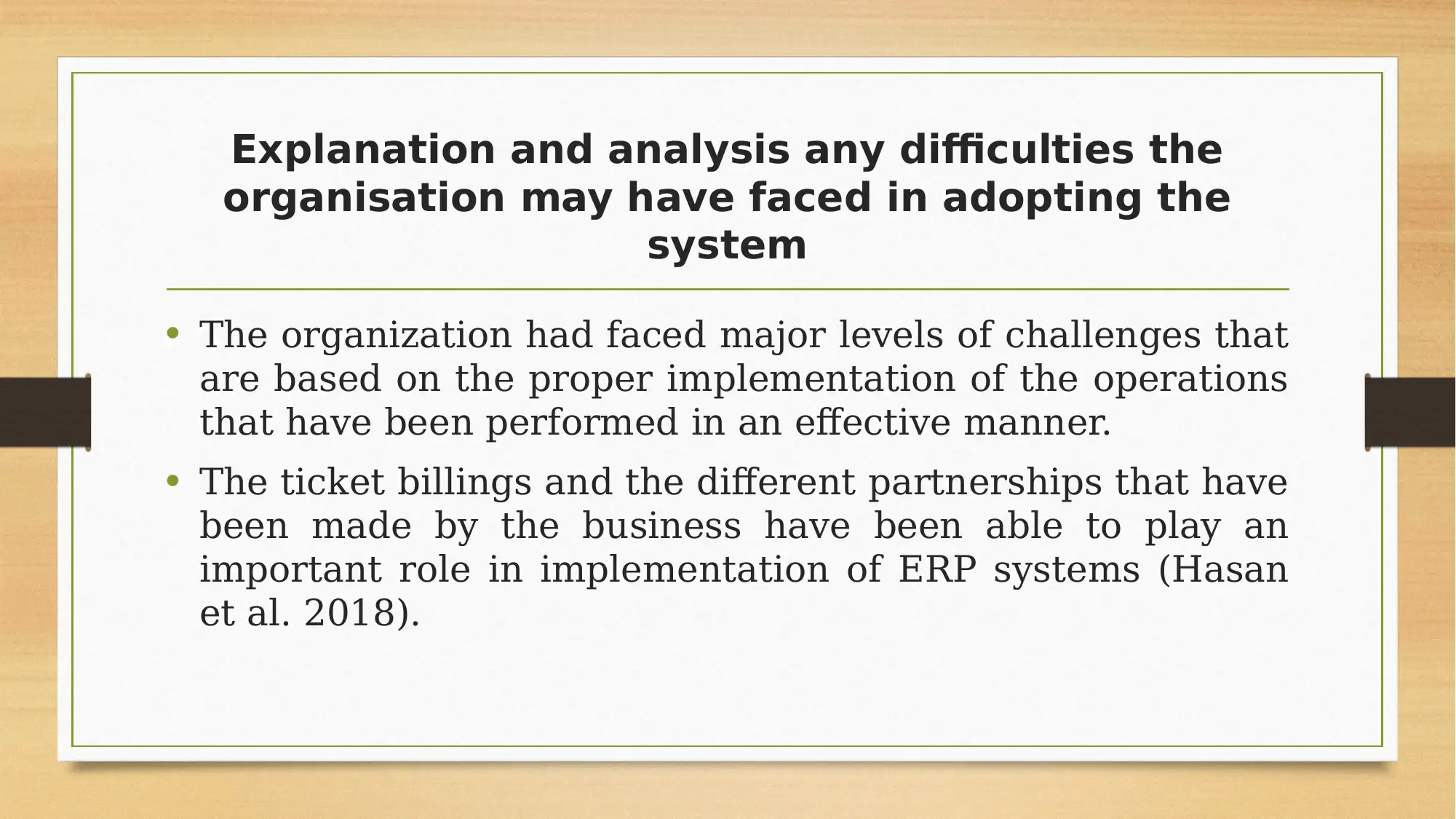
Explanation and analysis any difficulties the
organisation may have faced in adopting the
system
• The organization had faced major levels of challenges that
are based on the proper implementation of the operations
that have been performed in an effective manner.
• The ticket billings and the different partnerships that have
been made by the business have been able to play an
important role in implementation of ERP systems (Hasan
et al. 2018).
organisation may have faced in adopting the
system
• The organization had faced major levels of challenges that
are based on the proper implementation of the operations
that have been performed in an effective manner.
• The ticket billings and the different partnerships that have
been made by the business have been able to play an
important role in implementation of ERP systems (Hasan
et al. 2018).
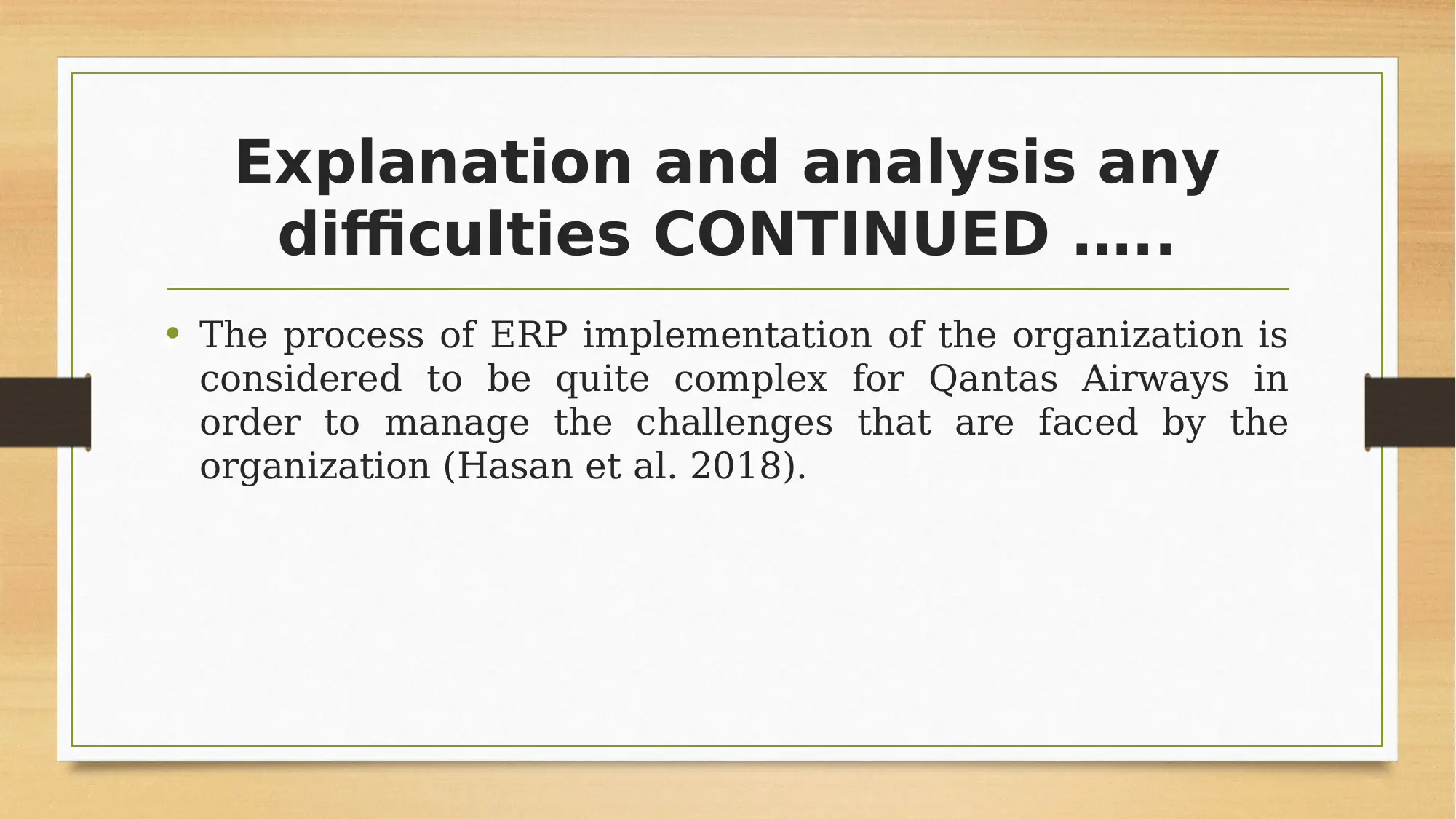
Explanation and analysis any
difficulties CONTINUED …..
• The process of ERP implementation of the organization is
considered to be quite complex for Qantas Airways in
order to manage the challenges that are faced by the
organization (Hasan et al. 2018).
difficulties CONTINUED …..
• The process of ERP implementation of the organization is
considered to be quite complex for Qantas Airways in
order to manage the challenges that are faced by the
organization (Hasan et al. 2018).
Paraphrase This Document
Need a fresh take? Get an instant paraphrase of this document with our AI Paraphraser
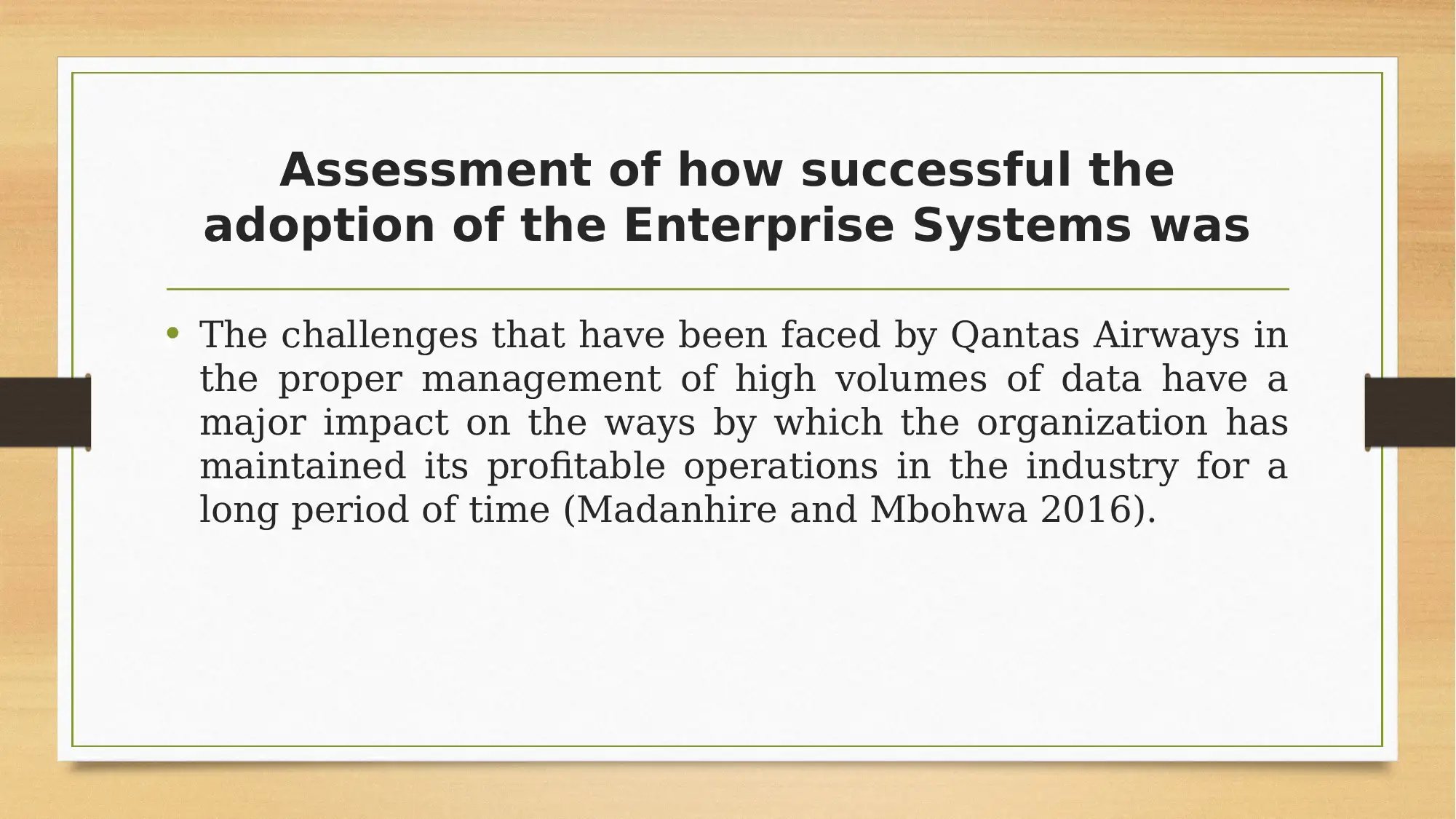
Assessment of how successful the
adoption of the Enterprise Systems was
• The challenges that have been faced by Qantas Airways in
the proper management of high volumes of data have a
major impact on the ways by which the organization has
maintained its profitable operations in the industry for a
long period of time (Madanhire and Mbohwa 2016).
adoption of the Enterprise Systems was
• The challenges that have been faced by Qantas Airways in
the proper management of high volumes of data have a
major impact on the ways by which the organization has
maintained its profitable operations in the industry for a
long period of time (Madanhire and Mbohwa 2016).
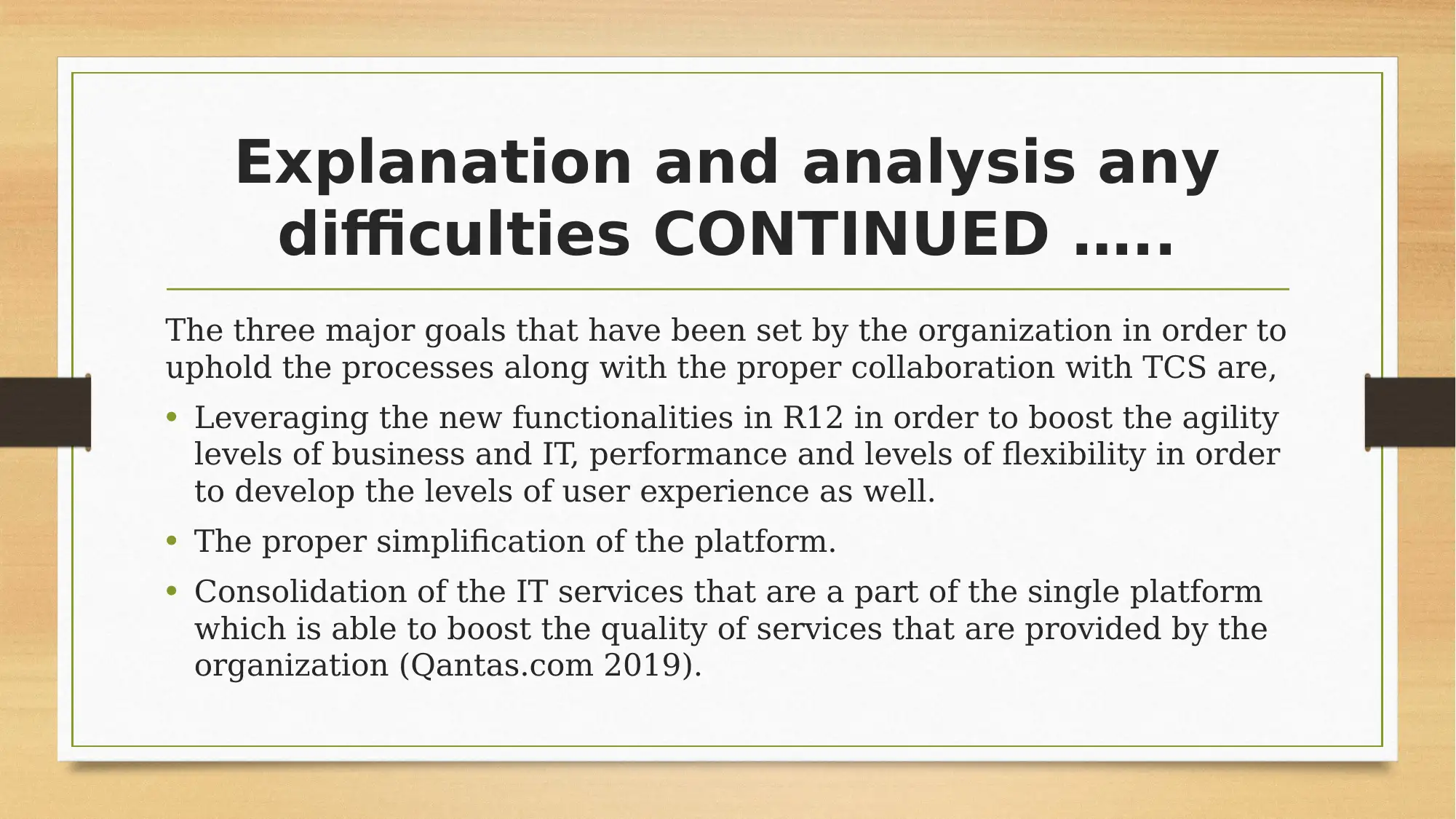
Explanation and analysis any
difficulties CONTINUED …..
The three major goals that have been set by the organization in order to
uphold the processes along with the proper collaboration with TCS are,
• Leveraging the new functionalities in R12 in order to boost the agility
levels of business and IT, performance and levels of flexibility in order
to develop the levels of user experience as well.
• The proper simplification of the platform.
• Consolidation of the IT services that are a part of the single platform
which is able to boost the quality of services that are provided by the
organization (Qantas.com 2019).
difficulties CONTINUED …..
The three major goals that have been set by the organization in order to
uphold the processes along with the proper collaboration with TCS are,
• Leveraging the new functionalities in R12 in order to boost the agility
levels of business and IT, performance and levels of flexibility in order
to develop the levels of user experience as well.
• The proper simplification of the platform.
• Consolidation of the IT services that are a part of the single platform
which is able to boost the quality of services that are provided by the
organization (Qantas.com 2019).
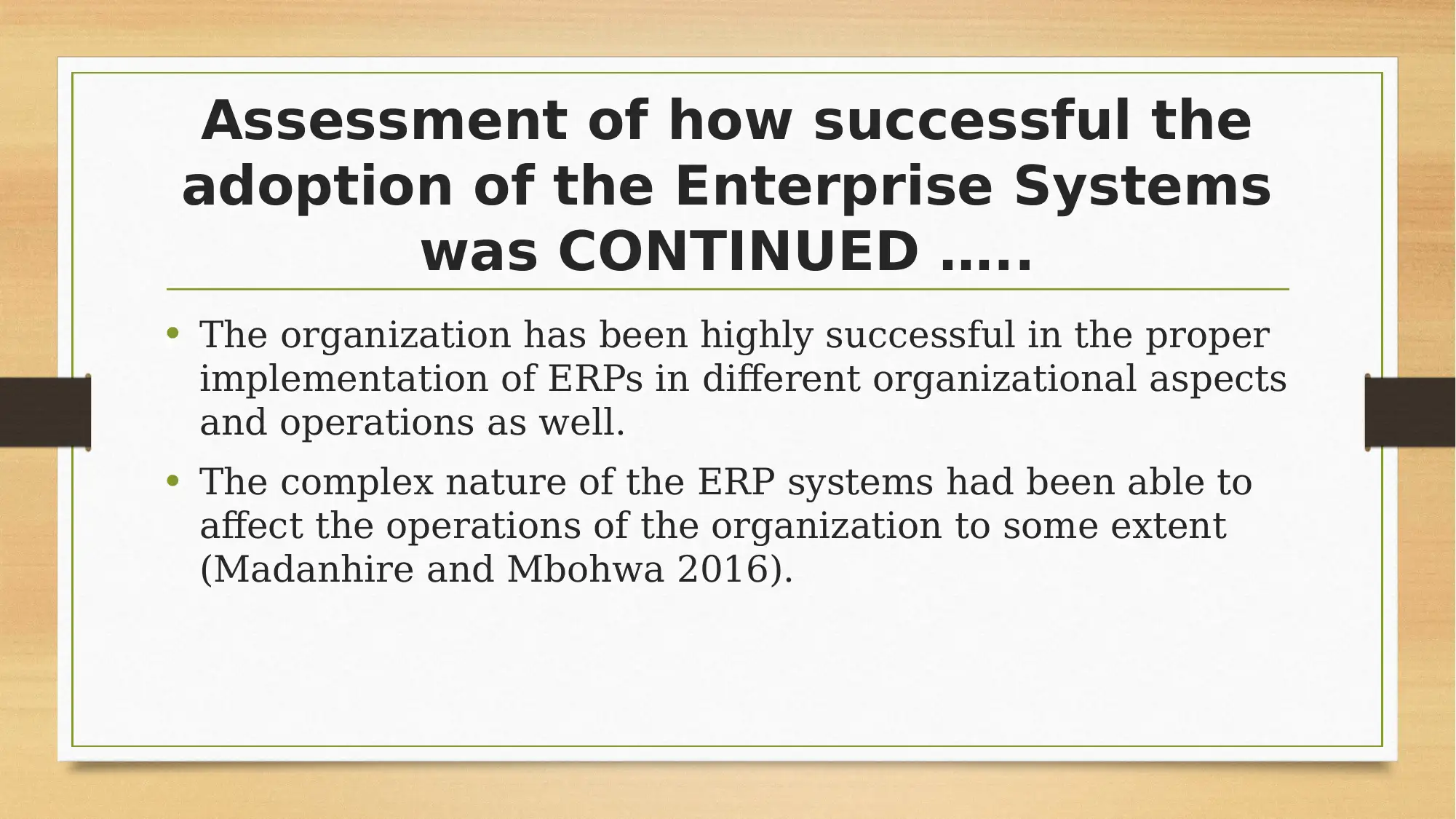
Assessment of how successful the
adoption of the Enterprise Systems
was CONTINUED …..
• The organization has been highly successful in the proper
implementation of ERPs in different organizational aspects
and operations as well.
• The complex nature of the ERP systems had been able to
affect the operations of the organization to some extent
(Madanhire and Mbohwa 2016).
adoption of the Enterprise Systems
was CONTINUED …..
• The organization has been highly successful in the proper
implementation of ERPs in different organizational aspects
and operations as well.
• The complex nature of the ERP systems had been able to
affect the operations of the organization to some extent
(Madanhire and Mbohwa 2016).
Secure Best Marks with AI Grader
Need help grading? Try our AI Grader for instant feedback on your assignments.
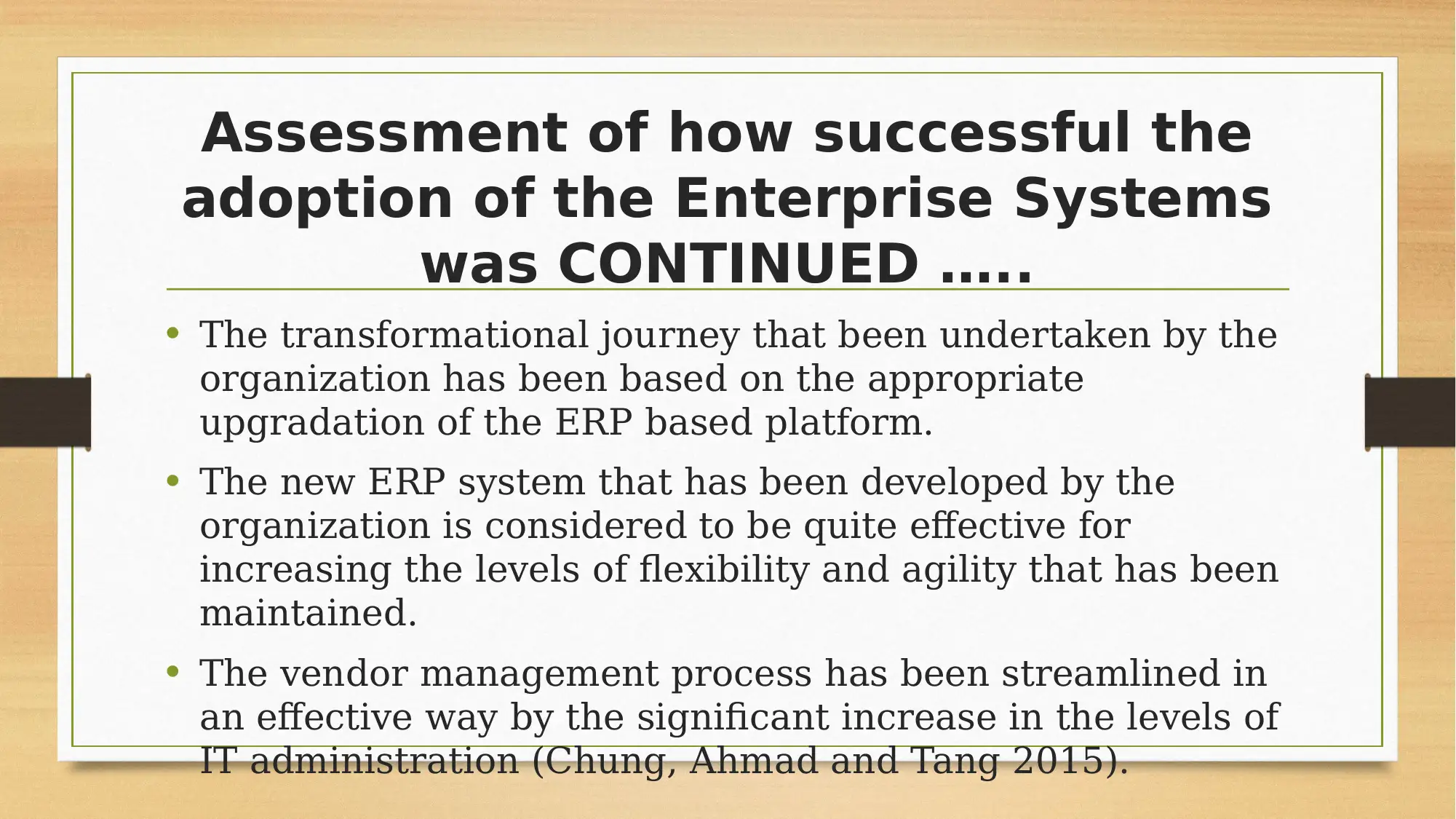
Assessment of how successful the
adoption of the Enterprise Systems
was CONTINUED …..
• The transformational journey that been undertaken by the
organization has been based on the appropriate
upgradation of the ERP based platform.
• The new ERP system that has been developed by the
organization is considered to be quite effective for
increasing the levels of flexibility and agility that has been
maintained.
• The vendor management process has been streamlined in
an effective way by the significant increase in the levels of
IT administration (Chung, Ahmad and Tang 2015).
adoption of the Enterprise Systems
was CONTINUED …..
• The transformational journey that been undertaken by the
organization has been based on the appropriate
upgradation of the ERP based platform.
• The new ERP system that has been developed by the
organization is considered to be quite effective for
increasing the levels of flexibility and agility that has been
maintained.
• The vendor management process has been streamlined in
an effective way by the significant increase in the levels of
IT administration (Chung, Ahmad and Tang 2015).
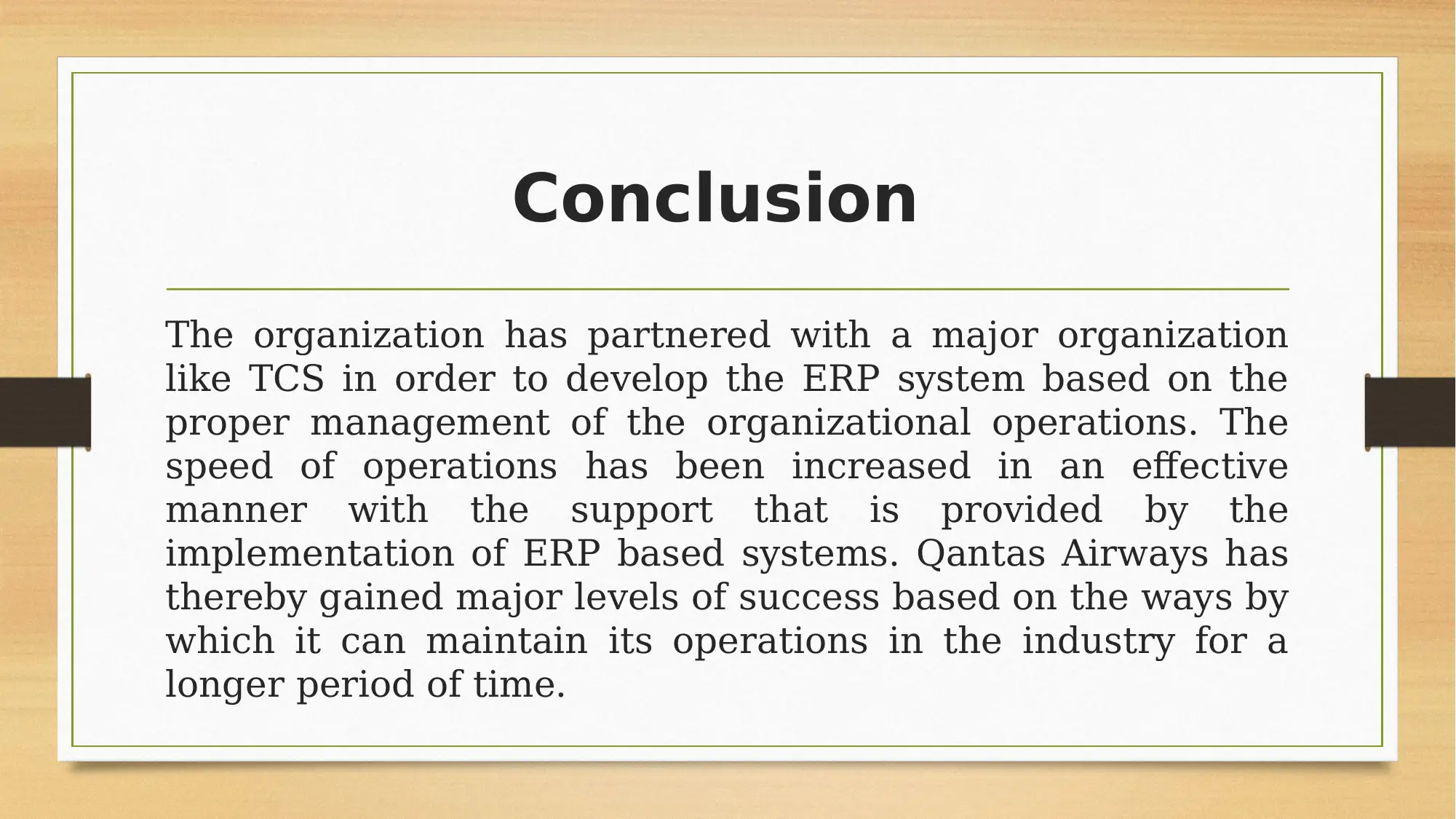
Conclusion
The organization has partnered with a major organization
like TCS in order to develop the ERP system based on the
proper management of the organizational operations. The
speed of operations has been increased in an effective
manner with the support that is provided by the
implementation of ERP based systems. Qantas Airways has
thereby gained major levels of success based on the ways by
which it can maintain its operations in the industry for a
longer period of time.
The organization has partnered with a major organization
like TCS in order to develop the ERP system based on the
proper management of the organizational operations. The
speed of operations has been increased in an effective
manner with the support that is provided by the
implementation of ERP based systems. Qantas Airways has
thereby gained major levels of success based on the ways by
which it can maintain its operations in the industry for a
longer period of time.

REFERENCES
• Chung, S.H., Ahmad, S.I. and Tang, H.L., 2015. Symptoms, causes and remedies
for failures in enterprise systems implementation. International Journal of
Business Information Systems, 19(1), pp.103-118.
• De Toni, A.F., Fornasier, A. and Nonino, F., 2015. The impact of implementation
process on the perception of enterprise resource planning success. Business
Process Management Journal, 21(2), pp.332-352.
• Hasan, M.S., Ebrahim, Z., Mahmood, W.H.W. and Rahman, M.N.A., 2018. Factors
Influencing Enterprise Resource Planning System: A Review. Journal of Advanced
Manufacturing Technology (JAMT), 12(1 (1)), pp.247-258.
• Madanhire, I. and Mbohwa, C., 2016. Enterprise resource planning (ERP) in
improving operational efficiency: Case study. Procedia CIRP, 40, pp.225-229.
• Chung, S.H., Ahmad, S.I. and Tang, H.L., 2015. Symptoms, causes and remedies
for failures in enterprise systems implementation. International Journal of
Business Information Systems, 19(1), pp.103-118.
• De Toni, A.F., Fornasier, A. and Nonino, F., 2015. The impact of implementation
process on the perception of enterprise resource planning success. Business
Process Management Journal, 21(2), pp.332-352.
• Hasan, M.S., Ebrahim, Z., Mahmood, W.H.W. and Rahman, M.N.A., 2018. Factors
Influencing Enterprise Resource Planning System: A Review. Journal of Advanced
Manufacturing Technology (JAMT), 12(1 (1)), pp.247-258.
• Madanhire, I. and Mbohwa, C., 2016. Enterprise resource planning (ERP) in
improving operational efficiency: Case study. Procedia CIRP, 40, pp.225-229.
Paraphrase This Document
Need a fresh take? Get an instant paraphrase of this document with our AI Paraphraser

1 out of 14
Your All-in-One AI-Powered Toolkit for Academic Success.
+13062052269
info@desklib.com
Available 24*7 on WhatsApp / Email
![[object Object]](/_next/static/media/star-bottom.7253800d.svg)
Unlock your academic potential
© 2024 | Zucol Services PVT LTD | All rights reserved.

